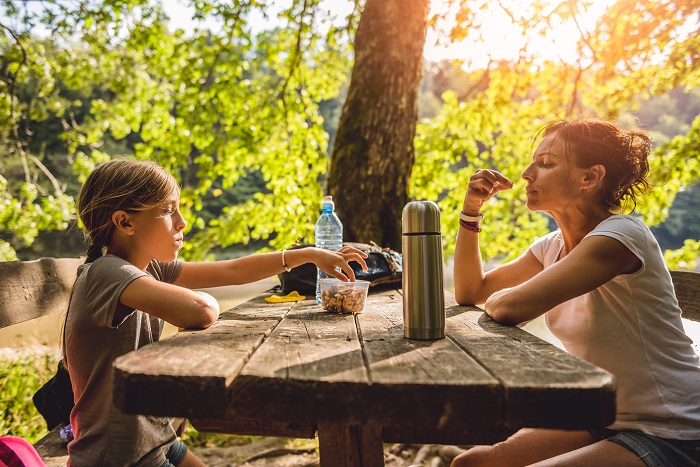I’m always amazed by how many times a day my three young kids ask for snacks. This is true at home, but it’s especially true when I take them hiking. It’s become so predictable that, roughly 35 feet into every hike, I stop and wait to hear those words: “Did you bring anything to eat?”
A snack stash can keep your children happy — and thus from being mistaken for rabid animals on the trail — but more importantly, healthy snacks also provide key nutrients for active little bodies. Here’s are some factors to consider when planning healthy snacks for your outdoor activities.
Eat This, Not That
From a practical standpoint, food should be kept at a safe temperature to reduce the risk of food poisoning. Cold foods should be eaten within two hours, or within one hour if the outside temperature is above 90 degrees. It’s probably best to save meat (with the exception of jerky), dairy, grains and some produce (like berries and peaches) for shorter activities.
Nutritionally speaking, the ideal snack includes a mix of the three macronutrients:
- Carbohydrates provide the most readily available energy during activity. Good sources include whole grains, fruits and vegetables.
- Protein promotes muscle growth and repair. It’s found in lean meats, beans, dairy and nuts, among other foods.
- Fat is the body’s energy reserve during longer activities. Good sources include nuts, seeds, coconut, avocado and oils.
A snack that includes all three of these nutrients ensures lasting energy to fuel the body. But it’s just as important to know what to avoid. Seemingly innocent and common snacks (like some protein bars) can be high in saturated fats and sugars. These, as well as trans fats, should be limited.
Healthy, Tasty Tidbits
Are you reeling from the revelation that your kid’s energy bar may not be so nutritious? Here are a few healthier options, listed from most substantial to lightest.
Did you ever beg for Lunchables as a kid? Homemade versions are a good way to offer all macronutrients in one package. Jillian Tedesco, founder of Fit-Flavors in St. Louis, creates healthy snack packs for her two young boys. “Kids love to see compartments when it comes to snacking,” said Tedesco. “I like to pack one fruit, one veggie, one protein, one complex carb and one healthy fat when packing a snack. Throwing in some dark chocolate makes them feel like they’re getting sweets.”

Healthy Homemade “Lunchables”
Speaking of sweets, trail mix is a great way to nourish little bodies while offering something fun and tasty. It’s good for longer activities because it doesn’t require refrigeration. “DIY trail mix is one of our favorite snacks,” said Mary Wissman, mom of three and a registered dietitian with McDaniel Nutrition Therapy in St. Louis. “Kids can create their own using all of their favorite foods. Before leaving the house, I put out dry cereal, dried fruit, nuts and seeds and let the kids fill their snack containers. They’re always more excited to eat anything they’ve had a hand in making.”
Do your kids prefer savory snacks? Drain and rinse a can of chickpeas. Pour onto a clean towel and gently pat out any excess moisture. Drizzle with a couple of teaspoons of olive oil, and dust with a little seasoning (such as ranch or taco seasoning). Roast at 450 degrees for 30 minutes, or until crispy. Brands like Saffron Road make packaged crispy chickpeas, but saturated fat and added sugar content can vary by flavor, so read the labels and be mindful of portion size.
Need a simple, grab-and-go snack? Pick fruit! “Fruit is the perfect snack for outdoor adventures with kids,” Wissman said. “It’s nature’s best ‘convenience food.’ It comes in its own wrapper that’s often edible, so you produce less trash. Fruit is also loaded with water and important nutrients that help keep you hydrated.”
Pair your fruit with a small handful of nuts or seeds for a balanced snack.
Food for Thought
If your kids are constantly asking for snacks on the trail, try to determine if they’re truly hungry. Like adults, kids are prone snacking when bored, tired or grumpy — and ritualistic snacking. If your family always stops to snack at the same picnic area during a bike ride, or if your kid requests M&Ms on a hike because “we always eat those on hikes,” then she may be eating out of ritual rather than hunger.
If your child complains of hunger early in an adventure, especially if he’s recently eaten, promote mindful snacking. Ask him if his tummy is grumbling. If the answer is no, he may need a break or mental stimulation, not food. Encourage him to rest his legs or help him connect with nature by asking questions and issuing challenges (“What’s the coolest rock you can find?”).
And when his tummy does start grumbling louder than an angry bear’s, know that you’re armed with snacks to fuel his active body and make adventures more enjoyable for the whole family.
Kim Yawitz is a freelance writer and registered dietitian in St. Louis.


Leave A Comment